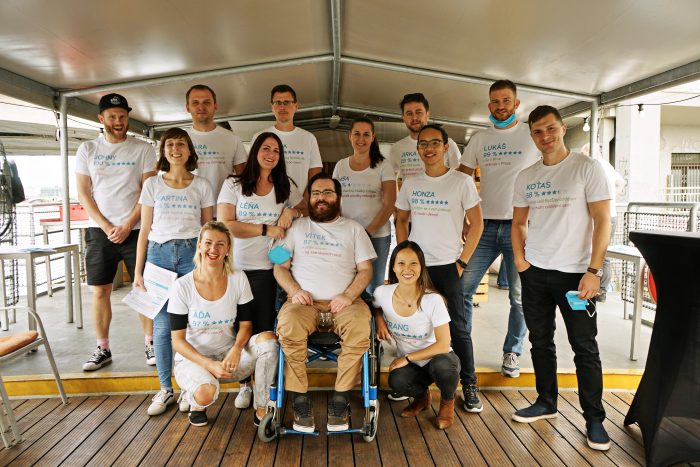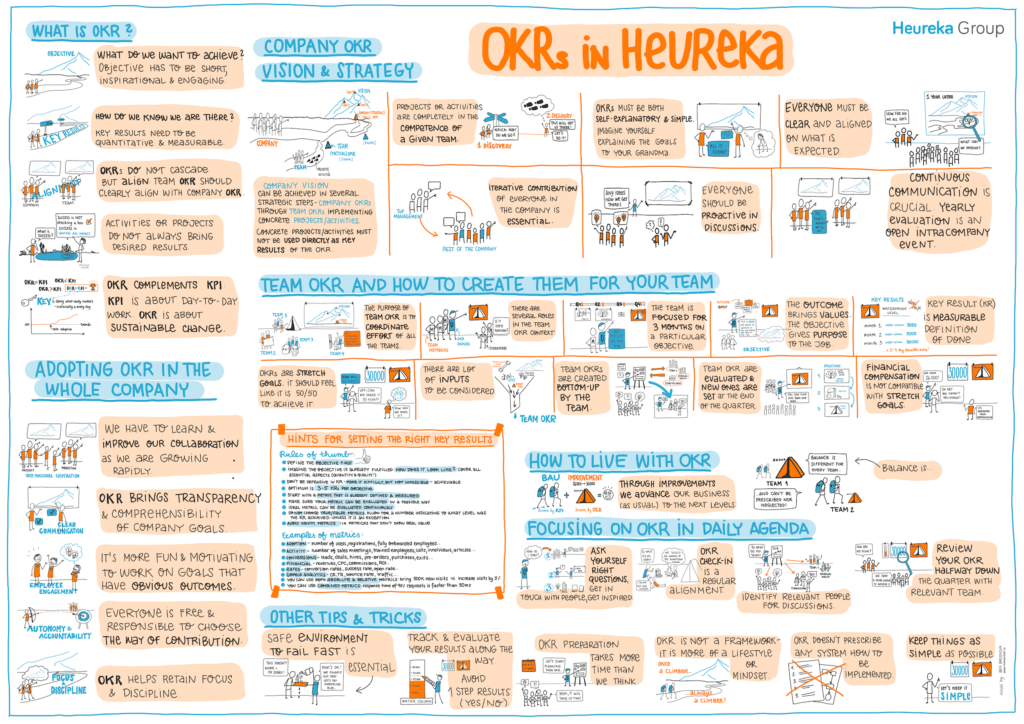Weekdone is a platform for OKR goal-setting that helps companies to achieve alignment, openness, and transparency around the most important business objectives. The tool is designed to support ambitious organizations in their OKR journey but we often find that theoretical definitions of the OKR principles do not guide leaders and teams well enough in the implementation process. That is why we present to you a first-hand example of the successful OKR journey from one of our customers.
We hope that these practical insights will help you avoid some of the pitfalls, and save you time and energy on your own journey.
The case study is written by Heureka Group
Background and vision
About Heureka Group
Heureka Group is Europe’s largest price comparison website and online shopping advisor. We simplify and facilitate online shopping for millions of customers every day.

Three years ago, the company was overloaded by various initiatives, lacked focus, and wasn’t moving forward with the product. But we had a vision: in product and development, we wanted to eliminate complex roadmaps and the long-winded and ineffective defining of concrete projects and deadlines. We wanted a goal-setting process that would give specific teams the possibility to decide what is necessary to do and when.
We were looking for a framework to help us indicate a clear and common goal to be in line with it and got the idea of OKR and inspiration to implement it from tech companies such as Spotify and Netflix. It’s important to say that Heureka Group has a very open company culture where autonomy and agility play a significant role. This was a perfect starting point.
Start of the journey
We started out with small teams in product and development two years ago. We tested it and discovered that OKRs supported and developed team responsibility and autonomous decision-making. The new process gave us significantly better business results, and it was easier to obtain management support once we had a track record to rely on. Then, we started rolling it out to the whole group.
We decided to start gradually getting buy-in from the colleagues in sales, customer support, marketing, and reception in all the countries in which we operate (offices in the Czech Republic, Hungary, and Slovenia). As an OKR pilot team of seven people, we prepared a multi-day online workshop for 60 leaders from the entire Heureka Group and shared the necessary know-how with them so they could pass it on to their teams. Thus, we helped our leaders to become teachers of OKR methodology.
Challenges of implementing OKR methodology
The OKRs should guide you to improve, and, therefore, intuitively make perfect sense for any organization. It sounds great, but no team in a company can dedicate itself to improvement 100%.
When you consider what already makes money for your company, you will, no doubt, discover that something is working very well and you want the teams to maintain their good practices and results. The key concept here is to “maintain” which means no sweeping changes.
This is where everyone should be reminded about the purpose and value of monitoring regular KPIs. These are suitable for dealing with current needs and challenges in processes we call ‘business-as-usual’ – standard company operations. Any team will always be at least partially responsible for some work that falls into the category of regular operations, and these operations should be monitored by performance against KPI targets.
So we are using both KPIs and OKRs but for completely different purposes (KPI for business-as-usual and OKR for improvement), allowing them to coexist, and ensuring they reinforce each other.
We also discovered that OKR and autonomy are not for everyone. Even though it was only a handful of cases, our corporate culture has already cost us a few employees.
Another thing to keep in mind is that the OKR process does not end with defining OKR at the beginning of the quarter. You need to regularly return to them and see what progress has been made and whether as a company you are getting closer to your objective.
Benefits of the OKRs
The main benefit is that OKRs unite and align different teams. The magic that makes OKRs work so well is actually in the mindset. Specifically, it’s a state of mind that allows people to search for opportunities and possibilities instead of getting discouraged by challenges.
It’s necessary to trust your people’s skills and expertise. By using the combination of OKR and KPI we are able to manage expectations. The people are bringing improvements and taking care of the business-as-usual at the same time.
We now know that in the beginning we really had no idea whether we could successfully manage our improvement process and decision-making through OKR. We have been figuring out the proper process gradually, step-by-step, and we had to mature and unite as an organization.
From our experience as a company with some remote teams, we realized that the OKRs helped us coordinate our activities more transparently. They contribute to the teams’ autonomy. Yet it is necessary for the company to have defined boundaries of autonomy and individual responsibility. It is not necessarily obvious to everyone that decision-making freedom also brings responsibility – not only for success but also for when things don’t work out. Taking responsibility for failure doesn’t mean pointing fingers and blaming each other. It means finding lessons and documenting learnings to ensure the same situation wouldn’t occur again. Learning and communicating this information is one of the greatest benefits of the OKR process.
OKR software
We discussed various tools, Excel included. At some point, we decided to use Weekdone as we needed to synchronize activities and initiatives of more than 50 teams across 3 countries on a quarterly basis.
Weekdone is helping us track, build structure, and see transparently what other teams are working on. Nevertheless, when using such a tool, it is necessary to keep onboarding the newcomers and reminding the teams to update Weekdone regularly. It is a continuous process.
In our case, once in a quarter, the whole company gathers and each team presents its OKRs. The company objectives are being presented by the CEO as well.
Aha! moments when introducing OKRs
This section was originally published in Czech on October 10th, 2020, on HeurekaDevs blog with the headline: “Our ‘Aha! moments’ when introducing OKR in 50 teams throughout Heureka Group”

#1 Every goal must make sense
- The objective must have a clearly and simply described meaning. Sometimes this is very difficult, yet the better you describe it, the greater sense your work has. It also means you sometimes discover something that doesn’t make sense.
#2 Management support is key
- It is difficult to introduce OKR if you don’t have management with an OKR mindset. OKR is a lot about focus – and teams won’t obtain it if management doesn’t respect quarterly OKR and assigns teams tasks ‘on the side’.
- It’s difficult to give up the ‘project management mindset’ – determining exactly what should be done and when it will be started – and, instead, start saying what the objective is and leaving it to the people to decide how to achieve it.
- Create a safe-to-fail environment – the success of objectives is never guaranteed, particularly with an ambitious approach.
- You also need to convince your investors that OKR is useful – preferably through results, which takes a long time – in our case almost a year.
#3 Mindset and culture must be ready for OKR
- OKR encourages autonomy – yet not everyone wants that responsibility.
- Teams must have continuous responsibility for specific product areas, otherwise, it doesn’t work.
- OKR is about ambition, yet ensure you have a safe-to-fail environment.
- Give priority to an outcome (versus output) mindset.
- OKR doesn’t necessarily suit every environment. Bear that in mind. Even when companies are ready for OKR, some don’t introduce it.
#4 Introduce OKR gradually
- We can’t imagine introducing OKR with a ‘big bang’ throughout a company.
- We started in the teams with the greatest inclination towards this – in our case, this was product/development – and gradually added other teams and departments – again, with us this meant marketing and sales. Then extended OKR to the rest of the organization in the following phases.
- This approach might be key for convincing both management and everyone else in the company. It is okay to start at the team level, and then arrange OKR at the company-wide level.
#5 It’s important to explain the company’s vision
- Everyone must know where you are going, to ensure they can see the purpose.
- Be careful – you might think that everyone knows the purpose, but you might have actually communicated it poorly or insufficiently.
#6 OKR and KPI, improvement versus BAU
- When we gradually introduced OKR to the company, we encountered situations when some teams said that OKR is not suitable for them. These were mainly ‘support’ teams that deal with a lot of operational matters. All teams deal with some types of operations to a greater or lesser extent. We call this ‘business as usual’ (BAU). OKR is something else, mainly about innovation and moving things forward. Every team must address innovation. We call this improvement.
- The point is that OKR is here to help you manage improvement, while KPIs are here so you know everything else is working as it should. We need both, although the proportion of work on OKR and KPIs can vary in each team.
#7 The best way to learn something is to teach it to someone
- We tried this when introducing OKR. We prepared a multi-day online workshop for 60 leaders from throughout the Heureka Group and shared the necessary know-how with them so they could pass it on to their teams. We helped leaders to become teachers of the OKR methodology. We learned a lot from this experience too.
#8 Sometimes it’s difficult to write measurable Key Results, but it pays off
- We have been struggling with how to set key results correctly so that they are measurable.
- People have a tendency to create done/not done tasks as key results. We encourage them to use some sort of an outcome-focused metric instead – has something improved?
- It’s difficult to find the correct measurement, and sometimes also difficult to measure qualitative changes – when there is no bottom line data or you don’t have tools to do it.
Do you feel ready to implement OKRs in your organization? Weekdone is an OKR software with coaching and ongoing support (all included in the subscription). Continue learning the methodology or sign up to get a free 14-day trial. We will guide you through the implementation process step-by-step and recommend the best course of action.